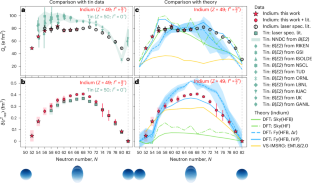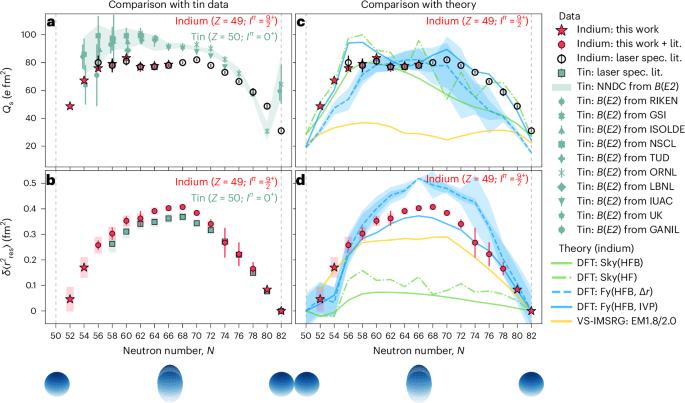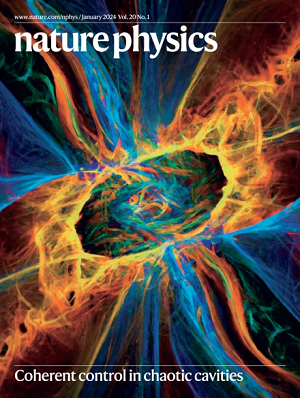铟同位素的电磁特性揭示了 100Sn 的双重魔法特性
IF 17.6
1区 物理与天体物理
Q1 PHYSICS, MULTIDISCIPLINARY
引用次数: 0
摘要
100Sn 被认为是质子数 Z 等于中子数 N 的最重的双魔核,了解 100Sn 附近的核特性一直是实验和理论核物理面临的长期挑战。特别是关于核集合性在核图这一区域的作用,存在着相互矛盾的实验证据。在这里,我们利用精密激光光谱法测量了铟同位素(Z = 49)在 N 从上往下接近 50 时的基态电磁矩和核电荷半径,从而为 100Sn 的双魔力特性提供了进一步的证据。我们的结果几乎涵盖了 N = 50 和 N = 82 时两个主要封闭中子壳之间的全部范围,并揭示了与中子数函数相关的抛物线趋势,以及向这两个封闭中子壳方向的明显减弱。我们的实验结果与两个互补的核多体框架(密度泛函理论和 ab initio 方法)的数值结果之间的详细比较揭示了核模型的缺陷,并为未来的理论发展确立了基准。本文章由计算机程序翻译,如有差异,请以英文原文为准。


Electromagnetic properties of indium isotopes illuminate the doubly magic character of 100Sn
Understanding the nuclear properties in the vicinity of 100Sn, which has been suggested to be the heaviest doubly magic nucleus with proton number Z equal to neutron number N, has been a long-standing challenge for experimental and theoretical nuclear physics. In particular, contradictory experimental evidence exists regarding the role of nuclear collectivity in this region of the nuclear chart. Here, we provide further evidence for the doubly magic character of 100Sn by measuring the ground-state electromagnetic moments and nuclear charge radii of indium (Z = 49) isotopes as N approaches 50 from above using precision laser spectroscopy. Our results span almost the complete range between the two major closed neutron shells at N = 50 and N = 82 and reveal parabolic trends as a function of the neutron number, with a clear reduction towards these two closed neutron shells. A detailed comparison between our experimental results and numerical results from two complementary nuclear many-body frameworks (density functional theory and ab initio methods) exposes deficiencies in nuclear models and establishes a benchmark for future theoretical developments. Precision laser spectroscopy of ground-state electromagnetic moments and nuclear charge radii of indium shows that 100Sn has closed proton and neutron shells. The results serve as a benchmark for future theoretical models.
求助全文
通过发布文献求助,成功后即可免费获取论文全文。
去求助
来源期刊

Nature Physics
物理-物理:综合
CiteScore
30.40
自引率
2.00%
发文量
349
审稿时长
4-8 weeks
期刊介绍:
Nature Physics is dedicated to publishing top-tier original research in physics with a fair and rigorous review process. It provides high visibility and access to a broad readership, maintaining high standards in copy editing and production, ensuring rapid publication, and maintaining independence from academic societies and other vested interests.
The journal presents two main research paper formats: Letters and Articles. Alongside primary research, Nature Physics serves as a central source for valuable information within the physics community through Review Articles, News & Views, Research Highlights covering crucial developments across the physics literature, Commentaries, Book Reviews, and Correspondence.
 求助内容:
求助内容: 应助结果提醒方式:
应助结果提醒方式:


